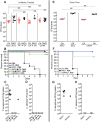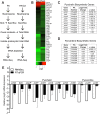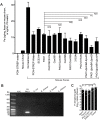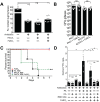Candida albicans Inhibits Pseudomonas aeruginosa Virulence through Suppression of Pyochelin and Pyoverdine Biosynthesis
- PMID: 26313907
- PMCID: PMC4552174
- DOI: 10.1371/journal.ppat.1005129
Candida albicans Inhibits Pseudomonas aeruginosa Virulence through Suppression of Pyochelin and Pyoverdine Biosynthesis
Abstract
Bacterial-fungal interactions have important physiologic and medical ramifications, but the mechanisms of these interactions are poorly understood. The gut is host to trillions of microorganisms, and bacterial-fungal interactions are likely to be important. Using a neutropenic mouse model of microbial gastrointestinal colonization and dissemination, we show that the fungus Candida albicans inhibits the virulence of the bacterium Pseudomonas aeruginosa by inhibiting P. aeruginosa pyochelin and pyoverdine gene expression, which plays a critical role in iron acquisition and virulence. Accordingly, deletion of both P. aeruginosa pyochelin and pyoverdine genes attenuates P. aeruginosa virulence. Heat-killed C. albicans has no effect on P. aeruginosa, whereas C. albicans secreted proteins directly suppress P. aeruginosa pyoverdine and pyochelin expression and inhibit P. aeruginosa virulence in mice. Interestingly, suppression or deletion of pyochelin and pyoverdine genes has no effect on P. aeruginosa's ability to colonize the GI tract but does decrease P. aeruginosa's cytotoxic effect on cultured colonocytes. Finally, oral iron supplementation restores P. aeruginosa virulence in P. aeruginosa and C. albicans colonized mice. Together, our findings provide insight into how a bacterial-fungal interaction can modulate bacterial virulence in the intestine. Previously described bacterial-fungal antagonistic interactions have focused on growth inhibition or colonization inhibition/modulation, yet here we describe a novel observation of fungal-inhibition of bacterial effectors critical for virulence but not important for colonization. These findings validate the use of a mammalian model system to explore the complexities of polymicrobial, polykingdom infections in order to identify new therapeutic targets for preventing microbial disease.
Conflict of interest statement
The authors have declared that no competing interests exist.
Figures







Comment in
-
The complexities of bacterial-fungal interactions in the mammalian gastrointestinal tract.Microb Cell. 2016 Mar 16;3(5):191-195. doi: 10.15698/mic2016.05.497. Microb Cell. 2016. PMID: 28357354 Free PMC article. No abstract available.
Similar articles
-
In vitro lung epithelial cell model reveals novel roles for Pseudomonas aeruginosa siderophores.Microbiol Spectr. 2024 Mar 5;12(3):e0369323. doi: 10.1128/spectrum.03693-23. Epub 2024 Feb 5. Microbiol Spectr. 2024. PMID: 38311809 Free PMC article.
-
Evolutionary dynamics of interlinked public goods traits: an experimental study of siderophore production in Pseudomonas aeruginosa.J Evol Biol. 2015 Jan;28(1):29-39. doi: 10.1111/jeb.12559. Epub 2015 Jan 6. J Evol Biol. 2015. PMID: 25421271
-
Role of Iron Uptake Systems in Pseudomonas aeruginosa Virulence and Airway Infection.Infect Immun. 2016 Jul 21;84(8):2324-2335. doi: 10.1128/IAI.00098-16. Print 2016 Aug. Infect Immun. 2016. PMID: 27271740 Free PMC article.
-
Candida albicans and Pseudomonas aeruginosa interactions: more than an opportunistic criminal association?Med Mal Infect. 2013 Apr;43(4):146-51. doi: 10.1016/j.medmal.2013.02.005. Epub 2013 Apr 23. Med Mal Infect. 2013. PMID: 23622953 Review.
-
Roles of Pseudomonas aeruginosa siderophores in interaction with prokaryotic and eukaryotic organisms.Res Microbiol. 2024 Sep-Oct;175(7):104211. doi: 10.1016/j.resmic.2024.104211. Epub 2024 May 9. Res Microbiol. 2024. PMID: 38734157 Review.
Cited by
-
The Spectrum of Interactions between Cryptococcus neoformans and Bacteria.J Fungi (Basel). 2019 Apr 12;5(2):31. doi: 10.3390/jof5020031. J Fungi (Basel). 2019. PMID: 31013706 Free PMC article. Review.
-
Unusual concurrence of P-solubilizing and biocontrol traits under P-limitation in plant-beneficial Pseudomonas aeruginosa P4: insights from in vitro metabolic and gene expression analysis.Arch Microbiol. 2023 Oct 13;205(11):355. doi: 10.1007/s00203-023-03692-9. Arch Microbiol. 2023. PMID: 37833514
-
Polymicrobial Ventilator-Associated Pneumonia: Fighting In Vitro Candida albicans-Pseudomonas aeruginosa Biofilms with Antifungal-Antibacterial Combination Therapy.PLoS One. 2017 Jan 23;12(1):e0170433. doi: 10.1371/journal.pone.0170433. eCollection 2017. PLoS One. 2017. PMID: 28114348 Free PMC article.
-
The interactions of Candida albicans with gut bacteria: a new strategy to prevent and treat invasive intestinal candidiasis.Gut Pathog. 2023 Jun 27;15(1):30. doi: 10.1186/s13099-023-00559-8. Gut Pathog. 2023. PMID: 37370138 Free PMC article. Review.
-
The activity of bacterial peptidylarginine deiminase is important during formation of dual-species biofilm by periodontal pathogen Porphyromonas gingivalis and opportunistic fungus Candida albicans.Pathog Dis. 2018 Jun 1;76(4):fty033. doi: 10.1093/femspd/fty033. Pathog Dis. 2018. PMID: 29668945 Free PMC article.
References
-
- Hermann C, Hermann J, Munzel U, Ruchel R (1999) Bacterial flora accompanying Candida yeasts in clinical specimens. Mycoses 42: 619–627. - PubMed
-
- Azoulay E, Timsit JF, Tafflet M, de Lassence A, Darmon M, et al. (2006) Candida colonization of the respiratory tract and subsequent pseudomonas ventilator-associated pneumonia. Chest 129: 110–117. - PubMed
-
- Bauernfeind A, Bertele RM, Harms K, Horl G, Jungwirth R, et al. (1987) Qualitative and quantitative microbiological analysis of sputa of 102 patients with cystic fibrosis. Infection 15: 270–277. - PubMed
-
- Gupta N, Haque A, Mukhopadhyay G, Narayan RP, Prasad R (2005) Interactions between bacteria and Candida in the burn wound. Burns 31: 375–378. - PubMed
Publication types
MeSH terms
Substances
Associated data
Grants and funding
LinkOut - more resources
Full Text Sources
Other Literature Sources
Molecular Biology Databases

